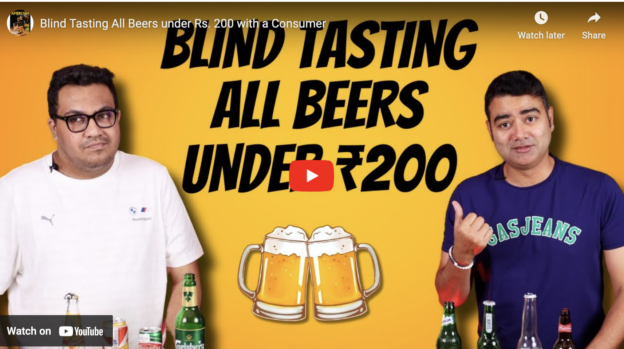
Category Archives: popular-posts

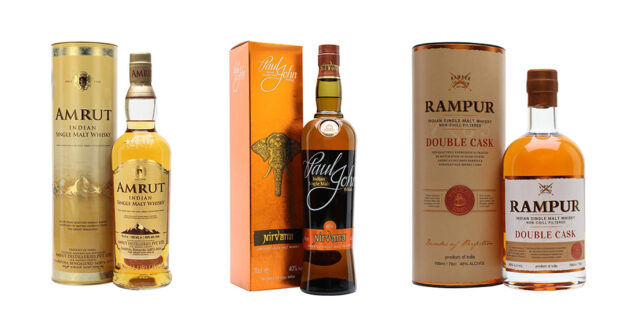
The Indian Single Malt Whisky Landscape
Indian Whiskies are experiencing a new high. With a growing drinking population the Indian alcobev industry is likely to boom to a new high.
In recent years, a formidable challenger has emerged from an unexpected corner of the world – Indian single malts. With their unique character and exceptional quality, Indian single malts have proven that they are more than capable of matching their Scottish counterparts.
One of the key factors that differentiate Indian single malts from their Scottish counterparts is the influence of terroir. India’s tropical climate, with its soaring temperatures and high humidity, creates a whisky maturation process unlike any other. The angel’s share – the amount of whisky lost to evaporation – is significantly higher in India, resulting in an accelerated aging process and intensifying the flavours within a shorter timeframe. This unique maturation process infuses Indian single malts with bold, robust flavours that tantalise the taste buds.
Amrut’s recognition placed India on the global whisky map, but Mohan Meakin pioneered Indian single malt whisky back in 1858, long before Amrut.
While Indri Diwali Edition’s win is celebrated in India, the perception differs internationally. Even though India strives for quality whisky production, global recognition is a work in progress.
Unlike established producers like Japan, India’s whisky prominence is relatively recent – the industry is shifting from the traditional older consumer to younger audiences, by diversifying consumption methods through cocktails.
More distilleries venturing into malt whisky production – Amrut, Paul John, Rampur, and newcomers like Piccadily aim for global market penetration amid rising Scotch whisky imports.
Indian single malts proudly celebrate the country’s rich heritage while incorporating modern techniques and influences. Distilleries often draw inspiration from local ingredients, spices, and cultural traditions to create whiskies that are uniquely Indian. From the use of Indian barley to the incorporation of regional flavours like cardamom, cloves, and saffron, these whiskies encapsulate the essence of India, offering a sensory experience that is both nostalgic and forward-thinking.
The meteoric rise of Indian single malts has not gone unnoticed in the whisky world. They have garnered numerous awards and accolades, winning over skeptics and enthusiasts alike. The recognition from renowned whisky experts and critics has solidified the position of Indian single malts as a force to be reckoned with in the industry. As more people discover the quality and complexity of these whiskies, their popularity continues to soar.
The emergence of Indian single malts has undoubtedly shaken the foundations of the whisky industry, challenging the long-standing dominance of Scotch whisky. With their distinct character, unique maturation process, and unwavering commitment to quality, Indian single malts have proven that excellence in whisky knows no geographical boundaries. As whisky enthusiasts and collectors seek out new and exciting expressions, Indian single malts stand ready to captivate their palates and leave an indelible mark on the world of whisky.
Despite the hype about the magnitude of Indian whisky compared to Scotch, actual consumption statistics show no drastic increase. However, global recognition for quality Indian whiskies has notably risen.
The bulk of India’s whisky market comprises blended and daily drinking whiskies, not just the premium single malts like Amrut/Paul John – underscores the dominance of everyday brands like Signature and McDowell’s. The knowledge and information of seasoned whisky enthusiasts have expanded significantly over the past five years, and they demand whiskies that are: high-quality; limited editions; priced conveniently available in a broader market.
Newer or curious consumers are gradually transitioning from lower-end to mid-segment whiskies, amplifying affordability in the ₹1500-₹2000 range.
While single malts garner recognition and elevate the industry’s stature, the substantial demand driving the industry’s profit lies within these affordable mid-tier whiskies.
Amrut’s pioneering strategy of launching single malts in the UK, rather than India, set a precedent for others like Paul John and Rampur. The idea was to create international demand that would pique curiosity domestically, a strategy that continues to shape the market.
The entry of big players like Diageo and Beam Suntory into India reflects the strategic shift to safeguard their market shares. Diageo’s move from importing Scotch to producing locally aims to counter the rising curiosity for Indian whiskies among consumers, particularly when price points are comparable.
Comparing Indian single malts with global counterparts – blind tastings often unveil the impressive quality of Indian whiskies.
Market acceptance remains a challenge due to the stronghold of brands like Johnny Walker and Chivas, deeply entrenched in the Indian consumer psyche.
Quality control emerges as a critical concern. Despite norms borrowed from the Scotch Whisky Association, the lack of a regulatory authority poses challenges. Looking ahead to 2024, manufacturers must grapple with the realities of production complexities and retaining skilled personnel. The absence of a consistent master blender/distiller in India points to the challenges of replicating Scotch whisky’s intricate craft.
Production transparency, along with quality control, demands attention, emphasising the need for a regulatory body to standardise practices. This prevents the replication of the Japanese whisky industry’s pitfalls, where lack of oversight led to a decline in repute.
International market alignment is crucial, but Indian single malt production capabilities are still dwarfed by Scotland. Expansion plans by major players like Amrut, Paul John, and Rampur indicate the industry’s growth trajectory.
The Future of Whisky Production
Accelerated maturation in India for quicker whisky development: The high Angel’s Share poses challenges due to significant evaporation losses. To counter this, distilleries are employing sophisticated warehouse management techniques to minimise losses and maximise output.
Exploration of alternate sources for key ingredients: Distillers are seeking sustainable and efficient means to procure essential elements for whisky production and exploring new avenues beyond traditional sources.
While currently in its nascent stages in India, there’s a growing emphasis on data-driven processes and automation. Techniques like employing spectrometers to analyse whisky flavours and aromas are being explored to ensure consistency and quality.
Manufacturers are associating with clubs and creating limited editions for various festivals like Diwali or Christmas. Brands are diversifying their offerings, aiming to capture consumer interest with specialised releases tied to zodiac signs, festivals, or master distiller editions.
Expansion into different spirit categories: This may redefine the industry landscape and provide diverse options for consumers beyond traditional whisky offerings. The future might also see a more adventurous consumer base exploring a wide array of whisky variants.
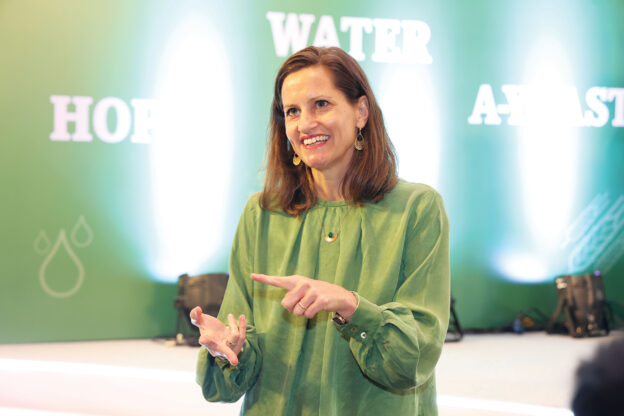
Heineken’s Five Star Experience
With millennials leaning towards fresher and lighter tipple, Heineken recently launched their Heineken Silver Draught beer in Maharashtra with the aim to make it available in other States soon. In an effort to educate the industry and the consumer, they also hosted a Star Serve programme that teaches the five steps on how their fresh draught beer should be served. Jacqueline Van Faassen, Head of International Premium Portfolio, Heineken India spoke to Bhavya Desai and Vincent Fernandes about the launch and plans moving forward. Excerpts:
The launch of the Heineken Silver Draught beer marks an important milestone for both, Heineken and United Breweries, who’ve been in India together since 2019. But while Heineken is a popular premium beer amongst the consumers, Van Fassen felt that the company was still missing on the draught experience, considering the trend where younger consumers are looking for a more fresher and lighter beer.
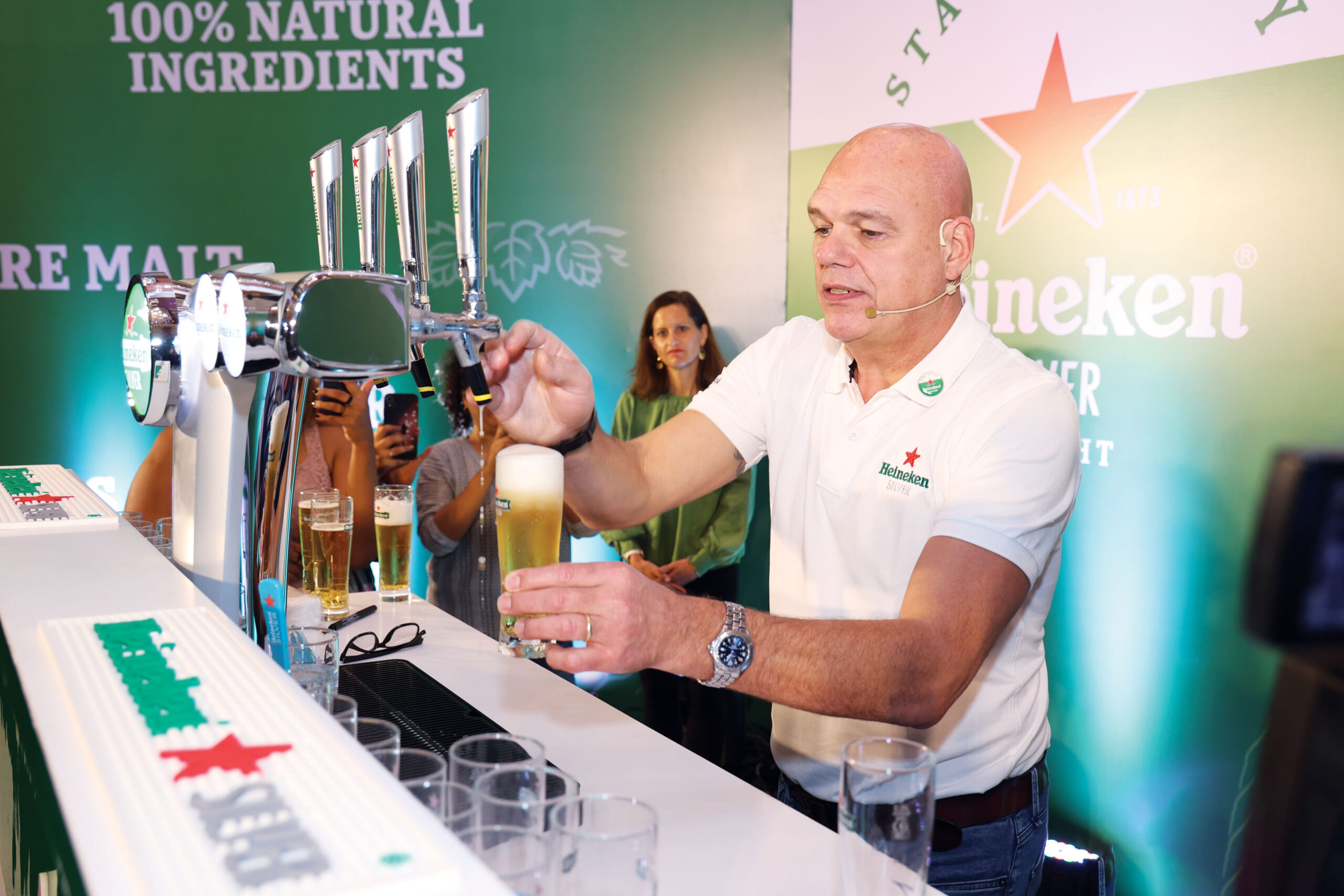
The beer is already popular and available in the global markets and gets its freshness from utilizing natural ingredients like its A-yeast and 100% malt. And the brand is hoping to have similar success with the product in India as well.
Hence they launched the new Heineken Silver Draught beer with the initial launch market as Mumbai, Thane and Pune, which will be supplied from their Taloja factory with an aim to expand to the other States soon, most likely Karnataka once the draught is started brewing there. Apart from Taloja where most of the Heineken beer is manufactured, the company also has brewing plants in Telangana with development underway for another brewery in Mysore, Karnataka.
But what’s interesting is that Heineken is not only looking to capitalise on their new product but also are making efforts to educate the bartenders on how to serve the beer, thereby hoping to educate the consumer touchpoints and the industry as a whole. “This week we educate 400 bartenders on how to pour Heineken draft beer. This includes 200 today in Mumbai and another 200 bartenders in Pune later this week. They are important stakeholders for us since they make sure that bring it to consumers in the best way,” says Jacqueline.
The training programme was led by Heineken’s Global Draught Master, Frank Evers, which includes the five step serve process to give the consumers the best experience of the tipple. The steps include cleaning the glass with cold water, pouring it at a 45-degree angle with the right amount of foam and finally skimming the extra foam off. The foam protects the CO2 keeping the oxygen out making the beer fresh for a longer time says Evers. What’s also unique to the beer is its brewing process, which is horizontally fermented as compared to the other lager beers which are brewed vertically.
But while serving the beer at the right temperature and with the steps seem interesting, whether the end consumer on-trade is really partaking at these points remains to be seen. But Van Fassen is confident that with the programme and efforts to educate the bartenders, once the consumers are served the beer correctly, they will identify with the quality and freshness of the product. Jacqueline is also aware of the potential of the draught beer category as a whole with a huge market that can be tapped on. She also states that the plans are that unleash the draught beer across India as soon as possible. And to do that they are focusing on activities like partnering with popular sports events like Champions League football. Recently the brand also hosted the F1 races across bars in Mumbai to further build on that social recall.
Govt Takes Big Decision, ENA outside GST
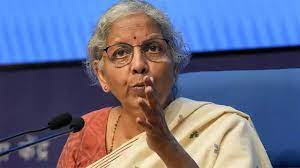
- Alcohol industry welcomes decision
- Council recommends cut in GST on molasses from 28% to 5%
The 52nd GST Council which met under the Chairpersonship of Union Minister for Finance & Corporate Affairs, Nirmala Sitharaman on October 7th took a significant decision with regard to Goods and Services Tax (GST) rates which has a positive impact on the alcobev sector. It has recommended to keep Extra Neutral Alcohol (ENA) used for manufacture of alcoholic liquor for human consumption outside of GST.
The GST Council recommendations will now be examined by the Law Committee on suitable amendment in law to exclude ENA for use in manufacture of alcoholic liquors for human consumption from the ambit of GST. The other recommendation is to reduce GST on molasses from 28% to 5%. This step will increase liquidity with mills and enable faster clearance of cane dues to sugarcane farmers. This will also lead to reduction in cost for manufacture of cattle feed as molasses is also an ingredient in its manufacture.
As per reports, a separate tariff HS code has been created at 8 digit level in the Customs Tariff Act to cover rectified spirit for industrial use. The GST rate notification will be amended to create an entry for ENA for industrial use attracting 18% GST.
It also clarified that job work services for processing of barley into malt attracts GST @ 5% as applicable to “job work in relation to food and food products” and not 18%.
The Council also made changes in GST rates on “Food preparation of millet flour in powder form, containing at least 70% millets by weight”, falling under HS 1901, with effect from date of notification, have been prescribed as: 0% if sold in other than pre-packaged and labelled form; and 5% if sold in pre-packaged and labelled form.
Briefing the media, the Union Finance Minister Nirmala Sitharaman said, though by law, the GST Council had the right to tax ENA as established by the judgment of the Allahabad High Court, the Council has decided to cede those right to the States. The issues around the taxability of ENA has been under consideration since the implementation of GST in 2017. Several states had opposed and challenged the right of the GST Council in imposing taxes on ENA. The Allahabad High Court has issued a judgement in the favour of the GST Council. As per the judgement, the GST Council has the right to impose taxes on ENA, and not the states. “If the states want to tax it they are welcome, if they want to leave it as it is, they can. In the interest of states, the centre has ceded that right to states,” Sitharaman said.
ISWAI welcomes recommendations
Mr. Suresh Menon, Secretary-General of the International Spirits and Wines Association of India (ISWAI) said, “Today’s decision by the GST Council to cede taxing control on un-denatured ethyl alcohol (commonly called Extra Neutral Alcohol or ENA) to the States is a major and very welcome step for the industry. It brings finality to an issue that has been hanging fire for the six plus years since GST came into being. The alcoholic spirits industry has been making the case for continuing to keep the taxation of this item within the taxing domain of the States, as had been the practice pre-GST. The possibility of an increase in taxes and hence in the cost of this essential ingredient in the manufacture of alcoholic spirits if ENA were to be taxed to GST, thereby pushing up the prices of the end alcoholic beverage, now falls away, and is very welcome. The industry is grateful to the members and the secretariat of the GST Council for this very critical decision for the sector. Likewise, also for the reduction in the rate of GST on molasses to 5% (from the current 28%), which should make for a level playing field for distillers of both grain and molasses (both integrated and standalone).”
CIABC thanks the Government for resolving long-standing demand
Welcoming the move, Mr. Vinod Giri, Director General of the Confederation of Indian Alcoholic Beverage Companies (CIABC) said, “We are very happy to see the GST Council give a definitive recommendation on the taxability of ENA used in making alcoholic beverages. ENA is nothing but high strength potable alcohol used as the primary ingredient for making alcoholic beverages after due dilution with water.
Ideally, the industry would have liked all of alcohol including the finished products be under the GST to bring parity in taxation across states. However, we know there are complexities involved in that but as long as alcoholic beverages are kept outside GST, putting ENA under GST and leaving the industry with a stranded cost would have made little sense, especially as companies do not have the freedom to pass on this tax in most states.”
Mr. Giri added that in the absence of clarity from the GST Council, Courts had taken conflicting positions on the matter which had further compounded the uncertainties.
“Industry has been pleading with the Council and other Government agencies involved for several years to bring finality on the matter. GST Council has also taken it up several times in its meetings but a definitive recommendation and closure had eluded. Considering that, the GST Council’s decision is a big relief to the industry. It will bring stability and settle nerves all over. “
He also mentioned that the CIABC had also recommended measures on related matters such as tax rate on molasses to bring a finality on the matter. “We are happy to see the Council recommend a comprehensive solution including reducing GST rate on molasses to 5% which should mitigate discomfort amongst the minority users buying molasses to make ENA.
On behalf of CIABC members and many other IMFL manufacturers, I thank the involved Governments and the Council for resolving a long-standing demand of the alcoholic beverages industry. We feel relieved.”
Allahabad High Court earlier had said ENA is subject to GST
Earlier the Allahabad High Court, in the case of Jain Distillery, held ENA is not covered under ‘alcoholic liquor for human consumption’ and is subject to GST. The decision had opened a floodgate of questions for the manufacturers/suppliers of ENA across the country, who have been paying VAT/CST on the sale, and also the buyers, who have been availing credits of such VAT and setting it off against VAT payable on the sale of alcoholic beverages.
The taxability of ENA has been the subject matter of deliberation for some years now. West Bengal has said the tax on potable liquor whose raw material comes from ENA must remain with the states; the ENA used for industrial purposes comes under GST, it said. Uttar Pradesh, where alcohol makes up more than 95 per cent of ENA, and other states such as Kerala, Tamil Nadu, Rajasthan, Telangana, Punjab, Madhya Pradesh, Chhattisgarh, and Karnataka wanted ENA to be kept out of GST.
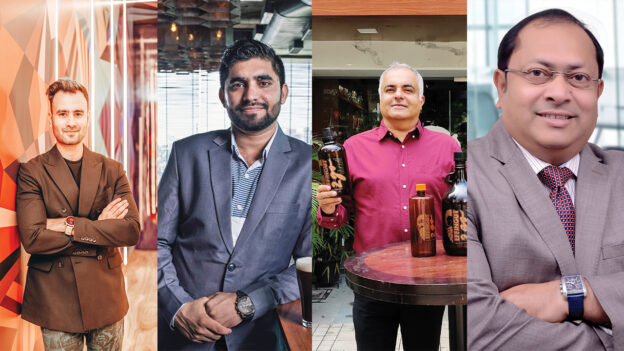
The Rise of Craft Beer and a Burgeoning Microbrewery Segment in India
Recent years have seen the rise of craft beer, a new crop of premium beer produced in small batches by independent producers. There are now strong indications that the growing demand for craft beer is paving the way for new microbreweries in India.
The beer industry in India has emerged in the last two decades to become a thriving money spinner today. Just a few decades ago, it wasn’t commonplace to find modern bars, restobars, lounges, and even friends sitting over a few beers. Today, there’s a new culture of brewing in India, even among millennials and Gen Zs, and beer has become trendy. As of 2022, the beer market was valued at 383.6 billion, growing at a CAGR of 8.1%, and expected to reach 622.4 billion by 2028.
Recent years have also seen the rise of craft beer, a new crop of premium beer produced in small batches by independent producers, with an emphasis on new and evolving flavours, enthusiasm, and techniques. There are now strong indications that the growing demand for craft beer is paving the way for microbreweries in India. Some industry players believe this is only the start of a journey that can transform the beer scene much more significantly.
Craft beer flexibility and a burgeoning segment
There’s a growing crop of craft beer producers and brands in India who seem determined to take over the beer market with what they call a breath of fresh air. “Being true to style and ingredients, the experience that craft beer provides in terms of flavour, aroma and array of styles has led to the growth of craft beer the world over. We often say that once one has tasted true craft, he’ll never go back to industrial lager, especially if craft is available within reach.
“This is the reason that the world and, indeed, India are seeing the growth of microbreweries. Industrial lager literally offers one-style-fits-all products, whereas craft gives the choice back to the consumer for its preferred taste profile and styles,” said Upesh Gulati, Founder, Strategist, and Master Brewer, Effingut Breweries Pvt Ltd.
Over the years, Effingut has taken pride in introducing patrons to various different styles from around the world. With 16 different craft beers on tap, there is a flavour for each and every patron to enjoy. As of today, Effingut has a pan-India presence with three different verticals across four cities that cater to any kind of patron. This includes the Effingut 2 Go boutique stores, Effingut Bistros, and The Effingut Brewpubs and Taprooms.
Rather than release large batches of single-flavour, often mundane beers, microbreweries offer a variety of tastes and flavours based on the changing preferences of consumers and innovativeness of producers. As more adventurous beer enthusiasts emerge, craft beer makers have to continually innovate and expand to meet growing demands. According to Dr. Nishant Grover, Brew Master at Hotel The Royal Plaza, craft beer has quickly become a trend in India.
“There are several factors responsible for the growth of microbreweries in India. First is the shifting consumer tastes and the desire for distinctive and expensive beverages, as well as the fact that they are becoming more daring and discriminatory in their taste preferences. Second, increasing disposable income has also contributed to the growth of microbreweries, and lastly, we must acknowledge the encouraging government policies that are making microbreweries like our own The Royal Brewery Bistro to thrive,” he says.
Creating richer experiences with richer flavours
Microbreweries like The Royal Brewery Bistro are also being fostered by the craze for the culture by both local and international tourists and beer enthusiasts. This contributes to the overall tourism sector in India. Beyond that, the most important changes are the ones seen in the lives of budding beer drinkers in India. Younger Indians are becoming adventurous and seek out newer tastes each new day.
“After a long hectic day at work, people would stop by a bar to relax with a mug of their favourite beer in hand. But now with changing demographics, millennials and Gen Zs, people’s taste for beer is also undergoing a shift. They are looking for something different to explore and experiment including their consumption of alcoholic beverages. It was only 20 years ago that the first breweries opened in the industrial city of Gurugram. Today, there are microbreweries spurring across the country. Well-known internationally trained brewers are brewing international quality beer recipes in new-world pubs and bars across the country. As the best quality raw material is available with ease, production becomes less hassle, this is why craft beer availability is spreading across the country. Multiple yearly events on brewing and brewing equipment have also propelled information sharing and technical know-how for the industry,” explains Sandeep Singh Katiyar, CEO of The Finch, one of the finest premium luxury lounges in India, known for its extensive range of freshly brewed craft beer.
Breaking the odds, surging ahead
There’s still a long way to go. The craft beer culture may be growing in popularity, but it is still relatively young in India. Brewing has certainly become easier because quality ingredients are easier to come by and the manufacturing process has been simplified. However, there’s a long path ahead, and it is rough and rocky. There’s need for both the central and state governments to support the segment and its operators for them to thrive even better and ensure the growth is smooth.
As Katiyar of The Finch puts it, “The new brewery policies in Haryana, Karnataka, Maharashtra, Andhra Pradesh, Karnataka, Rajasthan, and Uttar Pradesh have helped craft beer businesses scale to new heights. However, craft beer and microbreweries yet have a long path to cover and have plenty of hindrances to cross in the upcoming years. The industry requires care, support, and nurture from the state and central governments. With the government’s support, the smooth growth of microbreweries can be ensured.”
The idea of authenticity loved by millennials is what is spurring the growth in the industry, and there’s need to support the over 200 microbreweries in India to succeed, while also ensuring new ones emerge, especially in far-flung cities and towns where they’re currently non-existent.
“It’s no secret millennials live life differently. Things no longer matter. Experiences do. Indeed, the potential rise of craft beer has paved way for many microbreweries in India. Millennials are clearly choosing experiences over things, fuelling the homecoming of microbreweries. They now know that there is much to the world of beer than just the dull and mass-produced bottled hard liquor. With hints of chocolate or sweet caramel, floral hops or fruity notes, rich coffee undercurrents and more – the options are tempting and endless. Today, India is now growing its own craft culture one sip at a time, and it will get even better in the future,” notes Anirudh Khanna Managing Director, Independence Brewing Company.
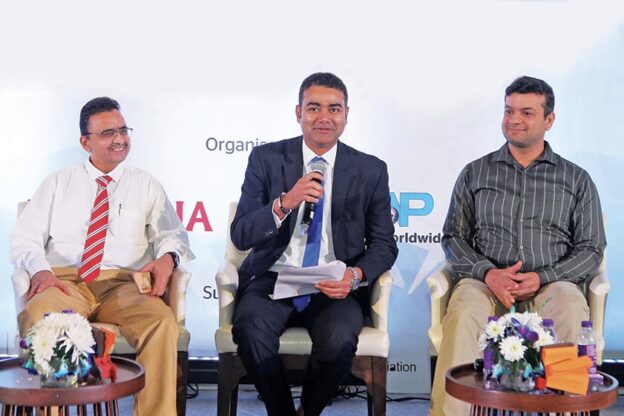
Innovations in Packaging, Adding to the Consumer Experience
The total sales of Indian-made foreign liquor (IMFL) products were 388 million cases in 2022, up from 305 million cases in the previous year with demand in all major segments like rum, gin, vodka, whisky and brandy rising. The rise has been the sharpest in premium products with their portfolio now accounting for a fifth of all the whisky sold in India and consequently demand for glass bottles and packaging material has shot up.
The bottling and packaging segment is a key component and along with ENA it accounts for over 65% of raw material costs for IMFL operators, who have been requesting price increases from the respective state governments, to offset high input costs.
While excise departments have their own yardsticks to concede price rise, the alcobev industry has to think of ways of bringing down raw material costs. One of the ways is to push their supply partners to go for innovations in glass bottling and packaging. Already, we are seeing a number of new packaging and bottling solutions such as bag-in-box, ceramic glass bottles, bag-intube, whiskey pouches and more. But the premium segment cannot do away with glass bottles as glass has its own charm. Design comes in play here.
All in all, the market of the glass bottle and packaging industry is expected to grow phenomenally, even as some companies are giving up mono-cartons. Extensive R&D to introduce biodegradable and sustainable packaging materials due to rising environmental concerns are fast gaining currency and companies are becoming increasingly environmentally sustainable entities.
Value creation without cutting corners
In view of its importance, Ambrosia at its 2023 Indspirit Conference in Delhi, organised a session on ‘Innovations in Packaging for value creation: cut cost without cutting corners’. The panellists included Srinivas Mantri, Sr Procurement Manager, Beam Suntory India; Vinod Sharma, Assistant Vice President (Commercial) Alcobrew. The session was moderated by Bhavya Desai, Group Head & CEO, SAP Media Worldwide Ltd. who set the tone by stating that in a competitive environment, the alcobev sector had to come up with bottling and packaging innovations for enhancing customer experience.
Abnormal increase in alcobev sales
Mr. Vinod Sharma said that in the last one and a half years, there has been an abnormal increase in alcohol sales and companies need to religiously work on cutting costs in a highly competitive world, without compromising on quality. The alcobev sector is banking on innovation of reducing weight of glass bottle while ensuring that it is not susceptible to breakages.
He mentioned that in the last two to three years there have been several innovations / techniques in bottling and packaging. One is the NNPB (Narrow neck press and blow) technique which can reduce weight of glass bottle up to 10 to 12%. However, over 90% of glass manufacturers in India have not adopted this technology due to initial investment costs. There is no substitute for glass bottle, particularly with premiumisation gaining currency, however glass manufacturers in India do not have adequate infrastructure to make bottles the way some foreign companies do.
Smart caps becoming smarter
The other areas the industry could look at includes smart caps with multiple options now with HDPE and metal combinations. “Smart cap is becoming smarter by the day.” Similarly, shipper cartons there are so many different varieties of material.
Sustainability should be key
Bhavya Desai nudged the panellists to talk about sustainability in packaging and Prof. K. Munshi, former IIT faculty, said while cost cutting is a factor by reducing bottle weight, making it compact etc., the sector should emphasise on value addition and how the consumer is benefitted. He gave a Japanese example where a manufacturer was dispensing Sake in small glasses which could be reused. “Sustainability also means next use of the product.” Most of the packaging is now thrown in to the garbage, he said and urged the industry to ‘put their minds together’ on sustainable packaging.
Innovation officers in companies
Prof. Munshi said presently the onus on cost reduction is on the bottle manufacturer which cannot happen due to reasons best known for the manufacturer. Hence, there is need for the alcobev sector to collaborate with the bottle supplier with regard to innovation. Companies should have innovation officer on board and whose full-time job has to be on innovation and value addition.
No alternative to glass bottles in premium segment
The professor underlined the importance of ‘thought process’ and research. “Whatever new technology comes in, one has to look at shapes, colours, aesthetics, the feel etc. how to get the maximum flavour, how to hold the bottle. These issues need to be looked into in a professional way. The user experience has to be factored in. You see many a time, empty bottles are kept as souvenirs. And as Indian companies we should think of what Indianness we can bring to the product through shapes, colours, culture etc. and how it complements with the bottle and the liquid within.” There is no alternative to glass bottles for premium category of alcobev as consumers do not prefer premium liquor in PET bottles.
Symbiotic relation between technology and design
While the big companies can bring in cost benefit partnering with the suppliers, the small players should leverage the flexibility they have by experimenting to the extent possible to offset costs. There is need for companies, irrespective of the size, to orient themselves to innovation and documenting it, even while adopting the best practices from around the world. Product development departments need boost. “Technology drives design. Development of technology takes a little longer, design is quicker but there is a symbiotic relationship between technology and design.”
Kaizen, continuous improvement to remove inefficiencies
Srinivas Mantri, Senior Manager, Beam Suntory India, talked about how the company came from a ‘Japanese thought process’ where continuous improvement or ‘Kaizen’ was in place. The idea is to keep removing the inefficiencies in the system. “Any innovation in our sector, it should factor in enhancement of customer experience and sustainability, giving back to the society, to nature.”
Beam Suntory is always working on these aspects, he said and mentioned that such processes had been implemented across different SKUs. “We have reduced the weight of the bottle, elevated the feel of the bottle, improved the label panels, reduced breakages.” Talking about glass bottles, he said, ‘see the liquid in the bottle, feel the bottle with hand and then taste the liquid… and also sound of the opening of closure…. consumer experience is involved and is demanding’. “The consumer wants something nice and something new.”
Bars display bottles, not mono cartons
He mentioned how in bars, one does not get to see mono cartons, but only bottles showing the liquid. Underlying the importance of thought process, Mantri said that from sourcing to the brand and to the consumer, there is an evolving journey, hence there is need to work with partners for continuous improvement. To engage the consumer, one needs to research who the consumer is and what we are giving to him or her, then comes tying up with internal and external partners. Importantly, consumer feedback has to be factored in and the entire process is on building the brand and consumer loyalty.
Anuj Bhargava, Managing Director, Kumar Labels, said there is a trend to remove mono cartons and when that happens, the focus is on the label on how it can be more attractive than the competition. Besides taste of the product, consumers pick the bottle for reasons such as the ‘look and feel’. Aesthetics is gaining considerable importance in this highly competitive market.
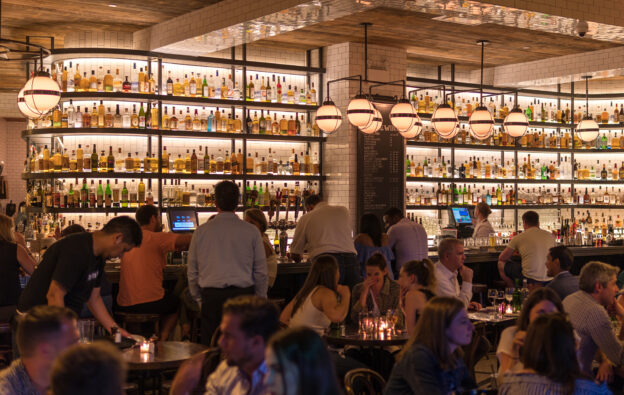
Experiential shopping: The rise of the flexible liquor consumer
From local rice beer and wine to the more complex sura, through varieties like palm toddy and cashew feni, India has always had a rich culture of alcoholic beverages. While the fancy bottles now adorn bar tables and home refrigerators, it is important to point out that the industry is more diverse than that. India’s alcobev industry has grown tremendously in recent years to become one of the nation’s star sectors. As of 2020, the industry had a market size of $52.5 Billion, with a projected CAGR of 6.8%, according to ICRIER.
Specifically, India’s liquor subsector is currently undergoing a revolution, triggered, inspired, and sustained by a growing crop of evolving consumers. The culture of experiential liquor shopping has now found a foothold across the urban and suburban cities, where consumers are as interested in the experience of shopping as the product itself. There are several alco-bev companies that now offer such experiences, including liquor tours, tasting, and so on. From Hyderabad to Bangalore, Delhi to Mumbai, Guwahati, and across the other cities, there’s something exciting for every liquor lover.
Transforming the Indian liquor scene with game changing experiences
Why gamble with your liquor purchase when you can choose the brand you like after a round of tasting? In Bangalore’s Mansionz from the stables of Living Liquidz, is a one-of-a-kind experience. Mansionz is a premium brand that offers premium experiences to premium customers. It is a liquor store with a wine-tasting room that offers that up-beat luxury New York feel. So, you can get an elite experience and have a taste of their amazing liquors before making a purchase.
Beyond the tasting experience, Mansionz is also a platform for learning about different kinds of spirits and brews, towards enlightening consumers about tastes, styles, texture, and value. As Moksh Sani, Managing Director of Living Liquids says, the essence is to build a deeper understanding and greater appreciation within the consumers about the beverages available to them. “I am highly enthusiastic about wines and foods, and it is that same passion I intend to share with every customer that walks into Mansionz or has a taste of any of our 1,500 uniquely curated wines at the top floor,” he says.
Beyond the liquors and classic cocktails served to interested tasters, and the exciting assortment of rum, vodka, gin, single malts, beers, and cognacs, the brand has gone a step further with the introduction of a mobile app that allows users to sample at least three spirits based on a predefined sum. Mansionz is just one of the many liquor store brands that are doing amazing things in India. In fact, some like The Liquor Store in Mumbai houses some extremely rare collections including the Special Edition Louis XIII Cognac with a price tag of Rs 3,95,000, the 1800 Milenio Extra Anejo Tequila, and the Taiwanese hotshot Kavalan’s whiskeys.
These rare offerings stand in the midst of around 1,500 different types of wines, 1,000 spirits, 250 champagne brands, and at least 100 different beers from different parts of the world. With side attractions like The Tavern, a London-style restobar that hosts pairing sessions occasionally and bring alco-bev enthusiasts under one roof and the Lift & Learn feature in the Liquor Store which gives a shopper the opportunity to learn about the history, tasting notes, texture, and other details of the beverage through an AR technology.
In the words of Dinesh Kathuria, co-founder of The Liquor Store at Belapur’s Palm Beach Road, the surge in alco-bev demand during the pandemic called for innovative measures to draw in larger crowds and take advantage of new enthusiasts. “It’s increasingly becoming about the experience. People need to see that you’re invested in their feelings and comfort; that you care about them. This involves creating the right environment, and building stronger customer service. It’s all about the service,” he adds.
A rising preference for experience and consumer service
Think of a restaurant and how you’re waited on, attended to, pampered and offered a tour of their menu (if you like). That is what liquor stores are now trying to achieve with such experiential shopping. The importance of adding variety and lifestyle options to liquor stores is a testament to the growing need to not just attract, but also keep consumers by personalising their experiences.
Another major concern is the “taboo” that surrounds women walking into a liquor store. Finding a way around this is what Mayank Shroff, Vikash Musaddi, Anant Shroff, Anurag Murarka, and Vikas Murarka envisioned when they created Hedonne. The Kolkata-based premium shopping hub offers a superb experience, which the founders say is the goal, and not necessarily a transaction. This is a first-of-its-kind in eastern India, offering a delightful walk-in experience for patrons to explore its over 9,000 bottles of various alcoholic beverages. And what about the Alcopedia corner? That’s an innovation that leaves curious customers more enlightened than they were when they walked in.
According to team Hedonne, “Women now have a comfortable space to walk in, ask about alcoholic beverages and even shop for themselves and their partners without any judgement. They can also try out the drinks before making a purchase, a concept that is first-of-its-kind in the city. For us, it’s about making the customers love the experience of shopping from us and enjoying it.”
It’s the same goal for The Whiskey Company, an 8,900 sq ft enclave in Guwahati, the alco-bev capital of North-east India. The moment you walk into The Whiskey Company; you’re greeted by a W-SET-certified sommelier who introduces you to the finest liquors the industry can offer. The Cuban cigar lounge and soon-to-be open tasting room are other amazing features you’ll find. This place, like most innovative settings, operates an open-door policy for expression. “There are no taboos or judgments here. This is why we have more women coming here than any other place in North-east India. We’re also concerned about educating our patrons and expanding their palates,” says Vishal Deorah, the company’s Managing Director.
Hyderabad and Bengaluru are two other places where experiential liquor stores are opening up. In fact, Bengaluru made news when Tonique, a boutique liquor store set up what became Asia’s largest liquor store built on a 25,000 sq ft land. Owned by Anith Reddy, the brand now owns two showrooms between the two cities. A tour of the store showcases the best wines and champagnes from India, Australia, New Zealand, France, Italy, Japan, and several other parts of the world.
Building brand loyalty and long-lasting memories
These trail-blazing brands have offered another side to India’s growing alco-bev industry; one that shows that beyond the magic of the brewers and distillers, great customer service and experience are a no-brainer. Together, they have garnered a growing crop of patrons who understand the value of the moments that lead up to a purchase. It is hoped that this crucial aspect of the liquor industry will continue to expand and add a pleasant flavour to the industry’s value chain.
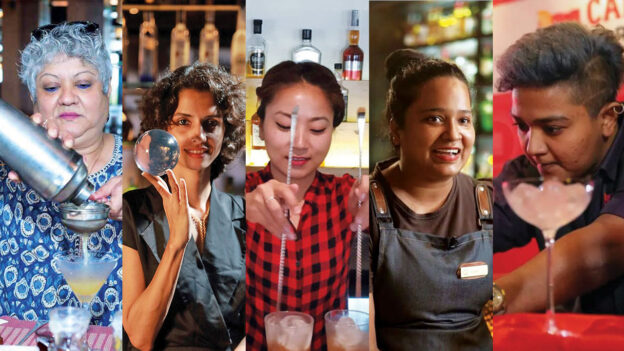
5 Women Bartenders who have made their mark
Working in a bar is a great career option for anyone with a creative mind and a drive to learn. The preconceived notion that bartending is a man’s field has been thrown out of the window in the past decade, with women from different social, cultural and academic backgrounds having set the standard high in this industry, by leading some of the best bars, discovering and creating new drinks and whatnot. This International Women’s Day, we’re celebrating some of the top female mixologists from India, who despite the challenges, have broken barriers and showcased their excellent skills behind the bar.
Shatbhi Basu
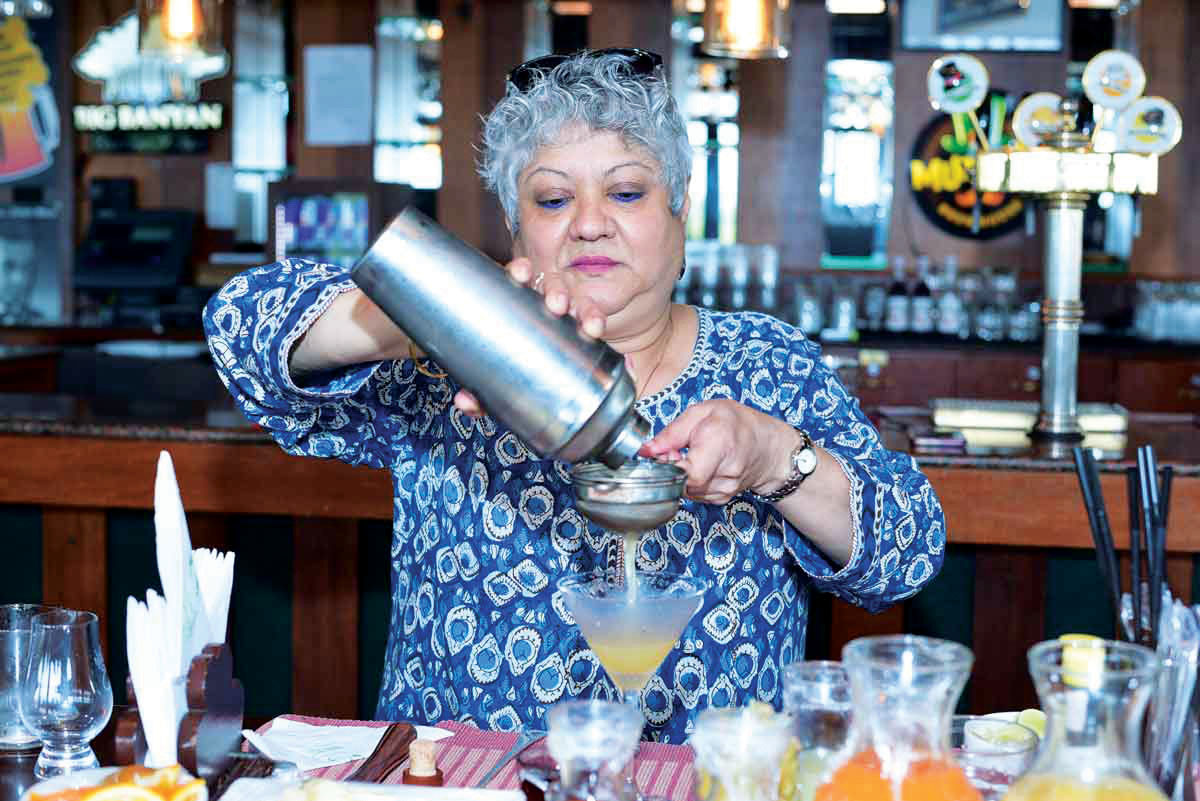
An alumnus of IHM Mumbai, Shatbhi Basu went on to carve out an illustrious career in bartending and was awarded by the President of India and the Ministry of Women and Child Development as India’s first woman bartender. With an experience of over three decades, Shatbhi runs her own bartending academy in Mumbai called Stir Academy of Bartending. She conducts various workshops across the country and tries to keep this art alive among women. She also authored the first comprehensive guide to alcoholic beverages and cocktails relevant to Indian conditions called ‘The Can’t Go Wrong Book of Cocktails’, and has hosted and created India’s first TV show on cocktails & more – ‘In High Spirits’ on NDTV Good Times. Shatbhi was appointed the first American Whiskey Ambassador, India from 2013 – 2016.
Ami Shroff
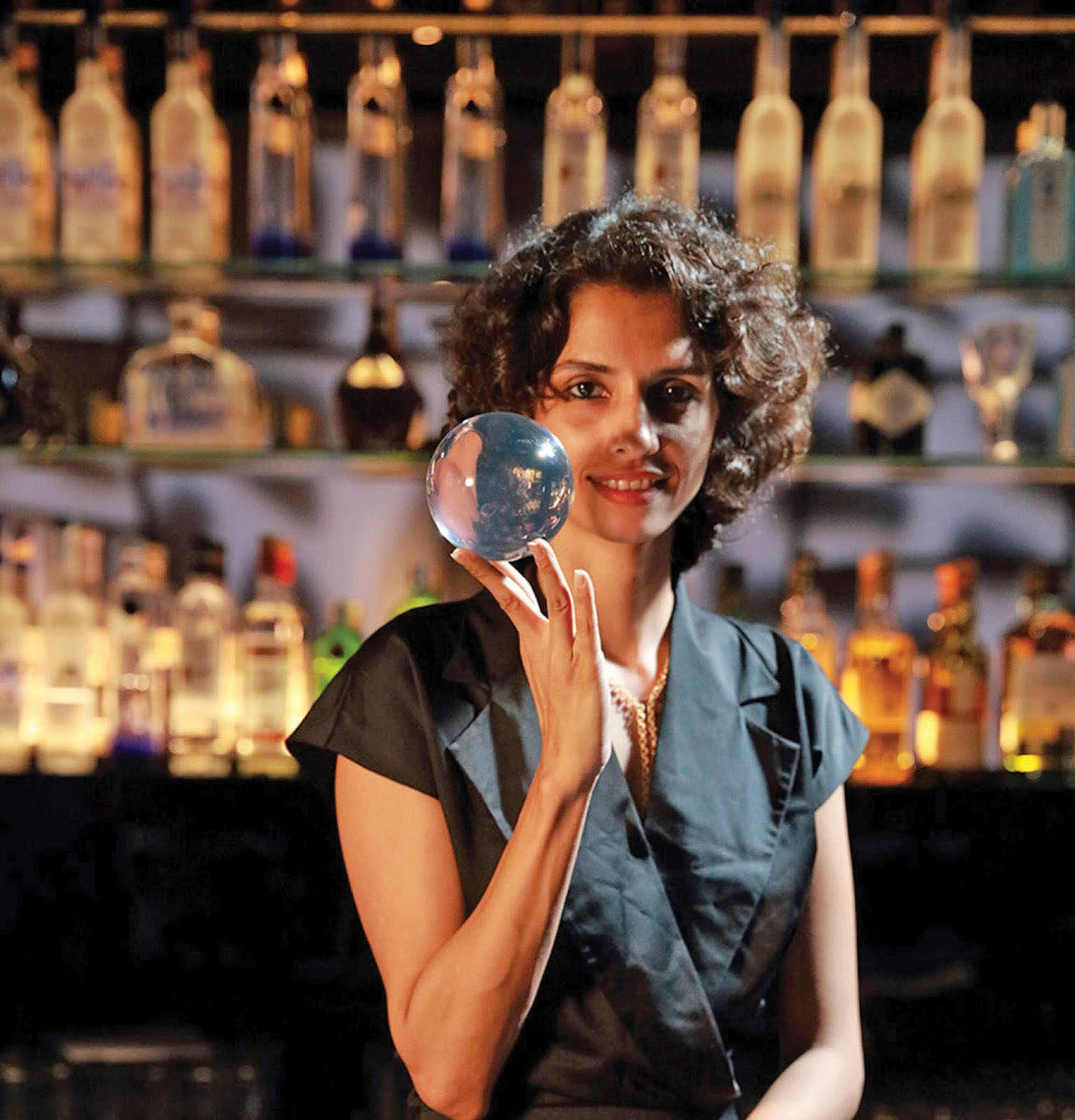
Ami Shroff started her career in 2003 at the age of 18. Since then, she has never looked back. Today she is one of India’s few women flair bartenders who is sought after for special events and gigs. If that’s not enough, she is also an accomplished mixologist which makes her a complete professional at the bar. She has managed to perform at over 20 destinations across India and beyond the borders, at over 1000 events, from backyard pool parties to elite corporate functions and conferences. Ami also curates cocktail menus for some of the most acclaimed establishments and has starred in the Netflix documentary Midnight Asia, depicting the mixing of drinks into performing art.
Cindy Lalramngaihzuali
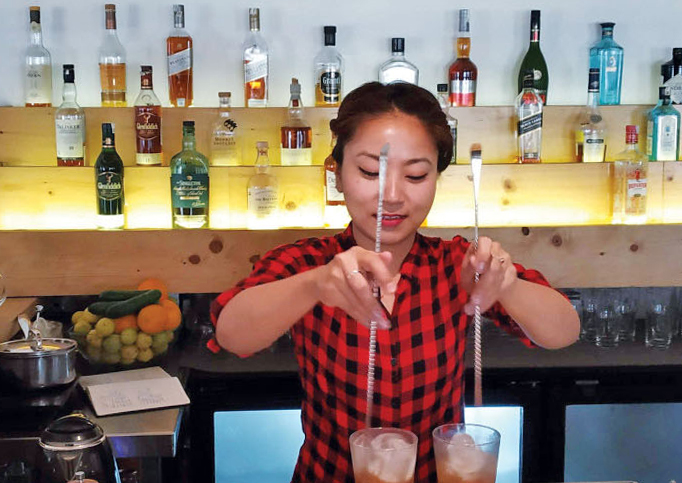
Cindy Lalramngaihzuali started her career in the F&B industry in 2015. After working in different departments, she got inspired after working behind the bar at Ek Bar in Delhi. Later, while doing a bartending course, she started working at Piso 16. After working for a month, she moved to Perch Wine and Coffee Bar, Delhi and takes care of Hoots’ cocktail bar there. One of her favourite cocktails is Hanky Panky – a spirit forward cocktail with gin, vermouth and Fernet Branca. Cindy considers her mother and grandmother as her biggest inspiration.
Sonam Rai
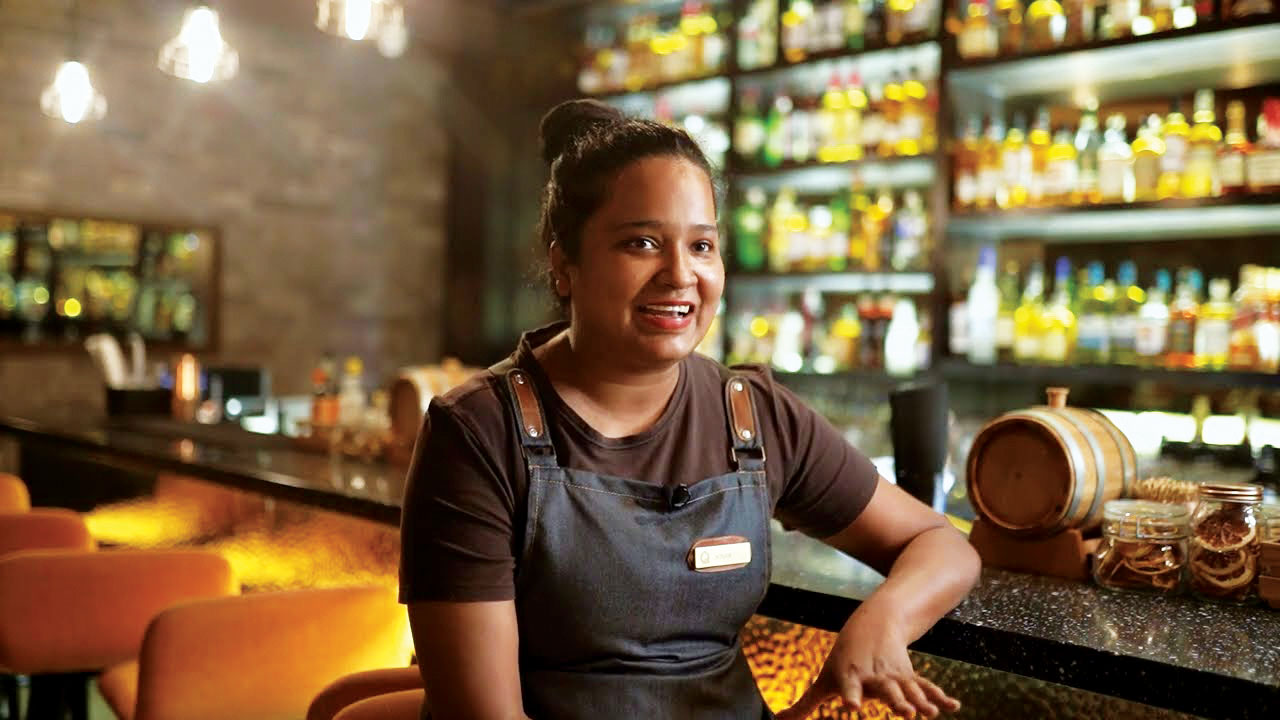
Hailing from a small town in Bihar and having no professional background in mixology, Sonam Rai is a hands-on and quick leaner of the craft. She credits he stint as an assistant bartender at GVK Lounge, Mumbai International Airport for her skills, where she picked up everything she knows from the Bar Manager Abhinay Patil. A big fan of dehydrated fruit garnishes and citrus drinks, try one of her grapefruit creations like the Bloody Habanero Margarita or Gin Grapefruit and Basil Ginger ale.
Arati Mestry
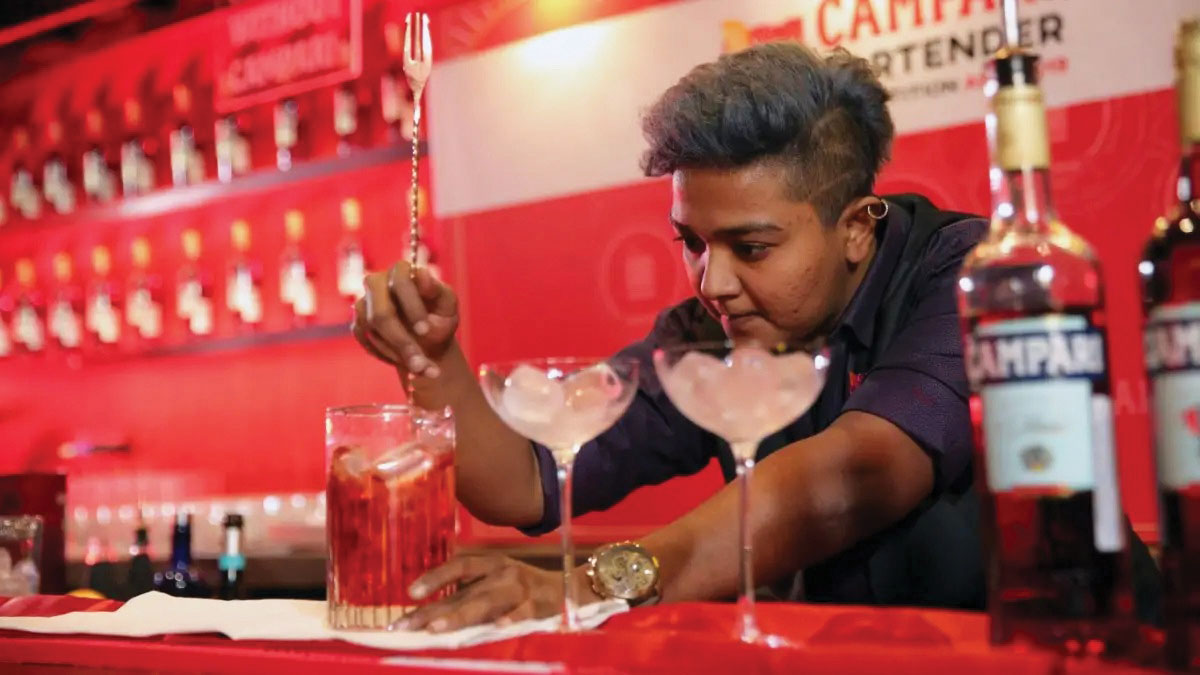
Arati Mestry’s journey towards being a bartender started with an impromptu cocktail competition in college and with a part-time job at a friend’s bar on weekends. After switching jobs, Arati took a small break to find a good workplace, and within some time landed a stint with BYG Brewski Brewing Co in Bangalore. She got her first job in the pre-opening team in Planet Hollywood Beach Resort, Goa, and then moved to Elephant & Co. Pune which, she considers, was a turning point. Currently she works with Seven Rivers Brewing Co, Taj Group, as a bar manager. Some of her accolades include being runner-up in the American Whiskey Legacy 2020, winner of the Jameson Barrelmen’ Face-Off 2018 (1st Edition), and national finalist in several competitions like the Campari Bartender Competition Asia 2019 – Top 5, the Monkey Shoulder Ultimate Bartender Championship 2019 – Top 5, and the Beluga Signature Bartender Program 2019 – Top 30.

Carlsberg Group appoints new Chief Executive Officer
The Carlsberg Group recently announced that Jacob Aarup-Andersen will join Carlsberg as Chief Executive Officer, replacing Cees ’t Hart, who will retire by the end of Q3 2023 at the latest. His starting date will be announced later.
Jacob Aarup-Andersen, who is Danish, joins Carlsberg from ISS A/S, where he has served as CEO since 2020. ISS is a global leader in facility management with 360,000 employees operating in 60 countries globally. At ISS, Jacob has led a financial turnaround and the development of a strategy with a core focus on technology and digitisation, sustainability and diversity, equity and inclusion. During his tenure at ISS, the company has regained its growth momentum, with 2022 results above expectations. Prior to ISS, Jacob had senior leadership roles at Danske Bank and Danica Pension. Before that, Jacob worked as an investment professional in firms such as Danske Capital, TPX-Axon Capital, Montrica Investment Management and Goldman Sachs.
Chair of Carlsberg’s Supervisory Board Henrik Poulsen says, “As part of our ongoing succession planning, the Board has been through a comprehensive assessment of CEO candidates from around the world, with Jacob Aarup-Andersen emerging as the best candidate. Jacob is an outstanding CEO with a strong track record in delivering shareholder value and organic and inorganic growth in addition to driving the ESG and digitisation agendas.
“Jacob brings a unique blend of excellent strategic skills, financial acumen and discipline, global operational experience and an engaging and purpose-led leadership style. We’re pleased that he’ll be leading the next stage of Carlsberg’s value-creating growth journey, and we’re looking forward to welcoming him at Carlsberg.”
Jacob Aarup-Andersen says, “I’m really looking forward to joining Carlsberg, a truly iconic company. I’ve always admired the unique heritage and strong values of Carlsberg and look forward to building further on that great foundation. The Group’s strong international presence as well as its brand portfolio and ambitious ESG agenda, combined with the long-term mind-set and the values of giving back to society through the Carlsberg Foundation, are truly inspiring.
“I’m very impressed with the successful journey that Carlsberg has been on these past years. Cees and the leadership team have created a strong foundation, both financially and strategically, and I will continue the strong shareholder value focus. I’m looking forward to working with the team over the coming years to further accelerate the full growth and value creation of this unique company.”

Radico Khaitan to invest ₹900 crores in UP, makes commitment at Global Investors Meet
• UP alcohol industry to get a boost with investments worth ₹16,392 crores
• Radico investing ₹650 crores in Sitapur 400KL grain distillery
At the recent Global Investors Meet in Lucknow, organised by the Uttar Pradesh government, Radico Khaitan, the fourth largest Indian liquor manufacturer, said it was committing investments worth ₹900 crores in UP, including the ₹650 crores in the new Sitapur 400KL grain distillery with an annual bottling capacity of 20 million cases.
Making a presentation on the opportunities for the liquor industry in UP, the Chief Operating Officer of Radico Khaitan, Mr. Amar Sinha said that the UP alcohol industry would get further boost as investments worth ₹16,392 crores would be made by different players. Radico is a major player in UP, contributing 24% (about ₹7,000 crores) of the state’s Excise revenue. Radico has Asia’s largest manufacturing plant in Rampur with three distilleries (molasses, grain and malt), Malt maturation facility and bottling lines, having invested about ₹1,500 crores. The Rampur plant recently converted its existing 140 KLPD molasses distillery into Dual Feed with an investment of ₹250 crores.
The Sitapur plant would generate 1000 direct and 2,000 indirect employments and contribute nearly ₹1,000 crores annually to the excise exchequer. The plant would manufacture IMFL, country liquor, ENA and Ethanol.
Giving an overview about Radico Khaitan which started in 1943, Mr. Sinha said that as one of the largest spirits manufacturer it was expanding capacity from 160 million litres to 327 million litres. It was strategically limiting interstate taxes and transport costs, having five own and 28 contract bottling units spread across the country. It was consistently increasing Prestige & Above brand contribution to total IMFL volumes; 53% in value terms. The gross revenue for FY 2022 was ₹12,470 crores with an EBITDA of ₹402 crores.
Radico Khaitan’s 8 PM has been the fastest growing whisky globally in 2022, being the 9th largest whisky globally by volume. Similarly, Magic Moments is the 12th largest vodka; Contessa, the 8th largest rum and Old Admiral, the 3rd largest brandy, all globally by volume.
UP volumes grown by 2.6 times
Mr. Sinha said with a progressive policy approach by the UP government, industry volumes had a compounded annual growth rate (CAGR) of 17% for Indian Made Liquor (IML) and 13% for Indian Made Foreign Liquor (IMFL). “Ever since the formation of the new government and policy, industry volumes have grown 2.6 times and we expect it to double in five years.” In 2016-17, UP distillery volume was 348.4 lakh cases of IML and 112.9 lakh cases of IMFL and the estimates for 2022-23 is 903.8 lakh cases of IML and 231.3 lakh cases of IMFL.
Highest excise revenue grosser
Citing figures, he said the excise duty collection had increased from ₹17,320 crores in 2017 to ₹40,400 crores in 2022-23 (estimated). Karnataka is a distant second at ₹24,580 crores. The UP revenue target for 2023-24 is ₹45,000 crores, having potential to touch ₹100,000 crores in five years.
To sustain this industry growth, an investment of ₹10,000 Cr has been made including an investment of ₹2,500 Cr in setting up grain capacity for potable liquor; molasses distilleries – ₹2,100 crores; bottling lines for country liquor ₹400 crores; present investment in IMFL (including ancillary industries) – ₹5,000 crores.
Mr. Sinha mentioned that UP was witnessing substantial flow of investments in the distillery sector with the Excise department having already got letters of intent worth ₹1,400 crores and signing 17 MoUs for setting up industries based on distillery, brewing and alcohol products. The state government has issued a mandate regarding approval of distilleries from different feeds such as molasses, grains, potatoes etc. and also eased rules for establishment of microbrewery in hotel bars. With a view to promote horticulture in the state, the government has exempted tax for five years for making fruit wine.
Simplified licensing process
The simplified licensing process, he said, was exemplary which many other states want to emulate. The ease of interaction with excise department has been transformational and like never experienced before in UP. Licenses are granted online in a timebound manner within 30 days after verification of all required KYC documents. The application is made online to the Commissioner of Excise through the concerned District Magistrate who then forwards his consent to Additional Chief Secretary (Excise & Sugar) and delivery of license is sent on WhatsApp besides online delivery. This process is applicable for all verticals like liquor, beer, winery, import and export permits.
Mr. Sinha mentioned that post 2017 (when Yogi Adityanath became the Chief Minister), the free market policy has been a game-changer. The government introduced a progressive excise policy, eliminated monopolistic nature of business and freed market at all levels of channels of distribution, starting from manufacturing to retail. While the consumer has a choice of brands, the industry has started expanding with a new level of confidence and exuberance.
Ethanol opportunity in UP
Delving on the ethanol opportunity in UP, Mr. Sinha said with ethanol blending target of 20% by 2025-26, there is a big opportunity for investment in grain distilleries for potable liquor and ethanol production. Giving an industry overview, he said the production of ethanol for blending with petrol was introduced in India in 2006-07 under the Ethanol Blending Programme (EBP). The initial target was blending of 5% ethanol with petrol by 2016-17 which got scaled to 10% by 2021-22 and revised to 20% by 2025-26. A 100 KLPD distillery would cost ₹120-130 crores (excluding land cost).
Ethanol production in August 2022 reached 327 crore litres and achieved blending ratio of 10.1% with UP contributed about 99 crore litres. The target is 1,016 crore litres by 2025 with sugar / molasses contributing 684 crore litres and grain 332 crore litres. Approximately 800-1000 crore litres of additional grain-based alcohol capacities are required by 2025 to meet the demand for 20% EBP and potable alcohol industry, thus opening up immense opportunities for grain distilleries in UP. The current India projects is 386 (molasses 263 and grain 123) and the capacity is 948 crore litres (molasses 619 and grain 329). The total UP projects is 85 (molasses 81 and grain 4) and the capacity is 209 crore litres (molasses 205 and grain 4).
Central Government initiatives
The Central Government has taken several initiatives for EBP and they include – Additional differential excise duty of ₹2 per litre on unblended fuel from October 2022; Financial assistance in the form of interest subvention @ 6% per annum or 50% of the rate of interest, whichever is lower for five years including one-year moratorium; Fixing remunerative prices of ethanol produced from different feed-stocks for the supply of ethanol to Oil Marketing Companies (OMCs); Reduced GST on ethanol meant for EBP programme from 18% to 5%; FCI rice and maize also allowed as feedstock; Environmental Clearance procedures simplified by the Ministry of Environment; Enhancement of storage capacities to store ethanol started by OMCs; Use of automotive fuel E12 (12% ethanol with 88% petrol) and E15 notified; Flexi-fuel engine and components (capable of running up to E85 fuel) included under PLI scheme; and Amendments to the National Policy on Biofuels to make India energy independent by 2047. The total requirement for 20% blending and other uses is 1,750 crore litres of alcohol (650 crore litres from sugar sector and 1,100 crore litres from grain-based distilleries) by 2025.
Liquor consumption to rise manifold in India in 5 years
Mr. Sinha said liquor consumption in India is set to rise manifold in the next 5-years and cited Boston Consulting Group (BCG) report which mentions increase 3.5 times from ₹31 trillion (3.1 Lakh Crore) to ₹110 trillion (110 Lakh Crore) over the decade ending 2018 of domestic liquor consumption. The report estimates consumption in India to touch ₹335 trillion (335 Lakh Crore) by 2028, exhibiting a CAGR of 13.2%, from its 2018 level.
UP is the second largest producer of sugarcane in India with molasses as the by-product for the alcohol industry. With 23.1 lakh hectares under cultivation, the state advisory price is above the fair and remunerative price of the centre. It is pegged at ₹340 per quintal as against ₹280-310 in South. The output value of sugarcane grew 43.9% from ₹24,860 crore to ₹35,770 crore over the decade ending 2022.
UP driven to achieve $1 trillion economy
Giving an overall view of the UP economy, he said the government is driven to achieve $1 trillion economy goal by 2027. The state scored high on Law & Order; Infrastructure & Connectivity; Power; Work Force; Raw material; and lesser political intervention. UP’s contribution to Indian economy as GSDP India: 100, UP 8; GSDP growth rate: 11.5 %, UP 8.43%; Per capita GSDP (US$) – India: 2,092 | Uttar Pradesh: 1,016; Cumulative FDI inflow (from Oct 2019-Jun 2022) (US$ million) – India: 158,879 | Uttar Pradesh: 995.
Mr. Sinha cited that the Chief Minister’s vision was laudable and that according to the Mood of the Nation survey, conducted by India Today & C Voters, 39.1% of respondents consider CM Yogi Adityanath as the best performing chief minister in the country. The survey was conducted in 30 states, thus making a case for UP as the best investment destination.
